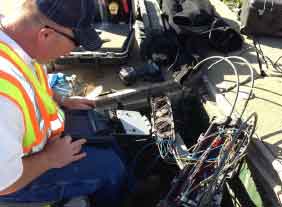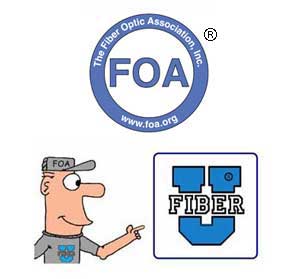Fiber
Optic Network Restoration MiniCourse
Fiber
U MiniCourses are courses on a specific topic that you can
take in about an hour or less. They are based on questions
people ask FOA all the time, so the topics are recommended
by our readers.
Level: Intermediate
Intended For:
Designers
of fiber optic communications networks
Users
of fiber optic communications networks
Contractors and techs who install, operate and maintain
them.
Objectives:
From this self-study program you should learn:
The
typical causes of fiber optic network outages
How
to design networks to reduce the chances of outages
How
to plan for restoration
How
to troubleshoot and repair outages
- Prerequisites

When
you finish, you can take an online exam on this course to
qualify for a "Fiber U Certificate of Completion." The
test cost for a Fiber U MiniCourse is $10US.
Introduction
All networks are susceptible to problems
that affect communications. A consequence of fiber optic
systems’ high bandwidth, long distance capability and
security is the extreme dependence of users on the
non-stop operation of these systems. They can transmit
large amounts of data long distances with immunity from
signal degradation and extremely high reliability, so
these systems usually carry the most critical data. By
critical data, we’re not talking about just telephone
conversations, Internet access or TV signals, we’re also
talking about connections for data centers, utility grid
monitoring and control signals, surveillance CCTV systems,
traffic control systems, airport monitoring and security,
and the like.

If something happens, it’s important to not panic. You
should have a plan, tools and components set aside for
repair and knowledgeable people on stall or a contractor
on call. When you design the network, restoration planning
should be part of the design. If you did not do that, now
is the time to do it before something happens.
Assignments
For
this lesson plan you will be instructed to watch 3 videos,
read
the references
and take a quiz (Test Your Knowledge) to complete the
course.
Lesson
Plans
Watch
the videos, read the section in the FOA Guide and take
the quiz. For this course, we recommend watching the
videos first and then reading the FOA Guide page on
Restoration. There is a short quiz you can use to check
your comprehension. The Certificate of Completion test
is based on those materials.
Videos
FOA
Lecture 51 Fiber Optic Restoration - Causes of
Damage To The Network
FOA
Lecture 52 Fiber Optic Restoration - Planning For
Restoration
FOA
Lecture 53 Fiber Optic Restoration - Troubleshooting And
Repair
FOA Guide
Fiber
Optic Network Restoration.
Test Your Comprehension
Fiber
Optic Restoration Quiz.

When
you finish all the assignments you can take an online test
on this course to qualify for a "Fiber U Certificate of
Completion." The test cost is $10US.
Go
here to take the Fiber U "Fiber Optic Restoration"
Certificate of Completion test. Here
are detail directions if this is your first time
taking a Fiber
U Certificate of Completion exam.
This information is
provided by The Fiber Optic Association, Inc. as a
benefit to those interested in teaching, designing,
manufacturing, selling, installing or using fiber optic
communications systems or networks. It is intended to be
used as an overview and/or basic guidelines and in no
way should be considered to be complete or
comprehensive. These guidelines are strictly the opinion
of the FOA and the reader is expected to use them as a
basis for learning, as a reference and for creating
their own documentation, project specifications, etc.
Those working with fiber optics in the classroom,
laboratory or field should follow all safety rules
carefully. The FOA assumes no liability for the use of
any of this material.
|


